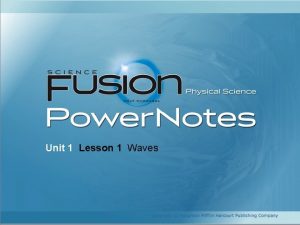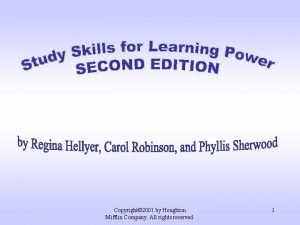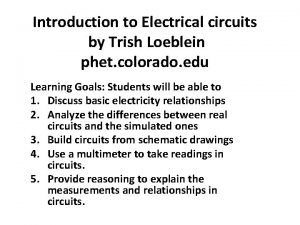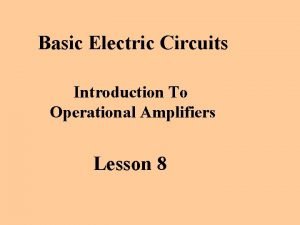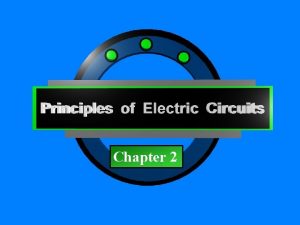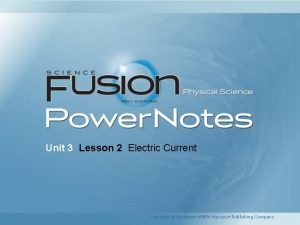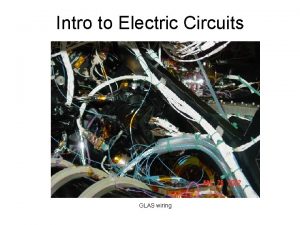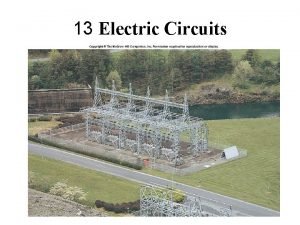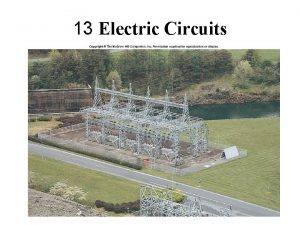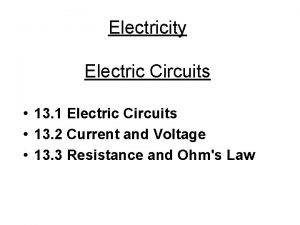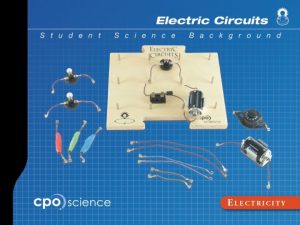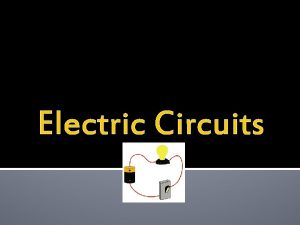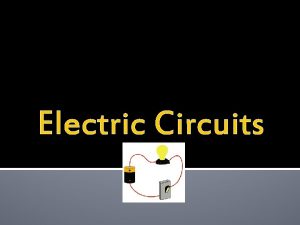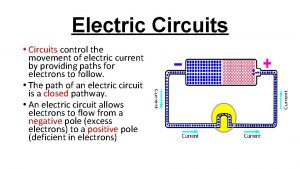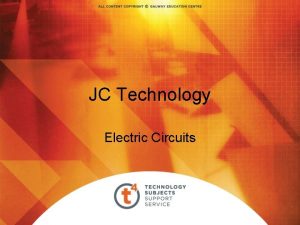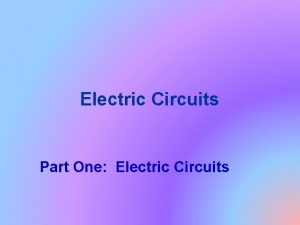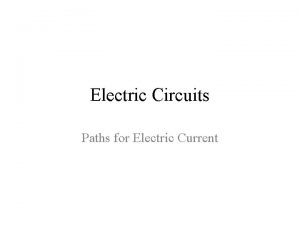Unit 3 Lesson 3 Electric Circuits Copyright Houghton



















- Slides: 19

Unit 3 Lesson 3 Electric Circuits Copyright © Houghton Mifflin Harcourt Publishing Company

Unit 3 Lesson 3 Electric Circuits A Complete Circuit What are the parts of an electric circuit? • An electric circuit is a complete, closed path through which electric charges can flow. • All electric circuits contain three basic parts: an energy source, an electrical conductor, and a load. Copyright © Houghton Mifflin Harcourt Publishing Company

Unit 3 Lesson 3 Electric Circuits What are the parts of an electric circuit? • The energy source converts some type of energy, such as chemical energy, into electrical energy. • One common household energy source is a battery. A battery changes chemical energy stored inside the battery into electrical energy. • A solar cell is an energy source that changes light energy into electrical energy. Copyright © Houghton Mifflin Harcourt Publishing Company

Unit 3 Lesson 3 Electric Circuits What are the parts of an electric circuit? • Inside a power plant, a form of energy such as chemical or nuclear energy is changed into mechanical energy. • Electric generators serve as energy sources for many homes and businesses. The electric generator changes mechanical energy into electrical energy. Power transmission lines deliver this energy to wall outlets in homes, schools, and other buildings. Copyright © Houghton Mifflin Harcourt Publishing Company

Unit 3 Lesson 3 Electric Circuits What are the parts of an electric circuit? • Materials in which electric charges can move easily are called electrical conductors. • Most metals are good conductors of electric current. Electric wires are often made of copper. • To protect people from harmful electrical shocks, copper wire is often covered with an insulator. An electrical insulator is a material, such as glass, plastic, or rubber, through which electric charges cannot move easily. Copyright © Houghton Mifflin Harcourt Publishing Company

Unit 3 Lesson 3 Electric Circuits What are the parts of an electric circuit? • A complete circuit also includes a load, a device that uses electrical energy to operate. • The conductor connects the energy source to the load. The load converts electrical energy into other forms of energy. • Examples of loads include light bulbs, radios, computers, and electric motors. Copyright © Houghton Mifflin Harcourt Publishing Company

Unit 3 Lesson 3 Electric Circuits Around and Around How are electric circuits modeled? • Circuits can be complex. A single computer chip can have many millions of parts. One tool that can be used to model electric circuits is a circuit diagram. • A diagram for an electric circuit shows all the parts in the complete circuit and the relationships among the different parts. Copyright © Houghton Mifflin Harcourt Publishing Company

Unit 3 Lesson 3 Electric Circuits How are electric circuits modeled? • This chart shows how each part of a circuit can be represented in a circuit diagram. Copyright © Houghton Mifflin Harcourt Publishing Company

Unit 3 Lesson 3 Electric Circuits How does current stop and start? • Electric charges move continuously in the closed loop of an electric circuit. A switch is a device that turns electrical devices on and off. • A switch is usually made of a piece of conducting material that can move. When the switch is open, the circuit is open. The circuit does not form a closed loop, so charges cannot flow. • When the switch is closed, the circuit forms a closed loop through which charges can flow. Copyright © Houghton Mifflin Harcourt Publishing Company

Unit 3 Lesson 3 Electric Circuits All Together? How do series circuits and parallel circuits differ? • Most electric circuits have more than one load. Simple electric circuits that contain one energy source and more than one load are classified as either series circuits or parallel circuits. • In a series circuit, all parts are connected in a row that forms one path for the electric charges to follow. The current is the same for all of the loads in a series circuit. Copyright © Houghton Mifflin Harcourt Publishing Company

Unit 3 Lesson 3 Electric Circuits How do series circuits and parallel circuits differ? • If one bulb burns out in this series circuit, the circuit is open and electric charges cannot flow through the circuit. So all of the bulbs go out. Copyright © Houghton Mifflin Harcourt Publishing Company

Unit 3 Lesson 3 Electric Circuits How do series circuits and parallel circuits differ? • In a parallel circuit, electric charges have more than one path that they can follow. Loads in a parallel circuit are connected side by side. • Unlike the loads in a series circuit, the loads in a parallel circuit can have different currents. However, each load in a parallel circuit experiences the same voltage. Copyright © Houghton Mifflin Harcourt Publishing Company

Unit 3 Lesson 3 Electric Circuits How do series circuits and parallel circuits differ? • In this parallel circuit, any bulb can burn out without opening the circuit. Copyright © Houghton Mifflin Harcourt Publishing Company

Unit 3 Lesson 3 Electric Circuits Safety First How can I use electricity safely? • Electrical energy can be hazardous if it is not used correctly. Electric circuits in buildings have built-in safeguards to keep people safe. • When using electrical devices, always pay attention to warning signs and labels. • Always pay attention to warning signs near places with high-voltage transmission lines. You do not actually have to touch some high-voltage wires to receive a deadly shock. Copyright © Houghton Mifflin Harcourt Publishing Company

Unit 3 Lesson 3 Electric Circuits How can I use electricity safely? • Never use electrical devices around water. • Pure water is a poor conductor of electric current. But water usually has substances such as salt dissolved in it. These substances make water a better conductor. This is especially true of fluids inside your body. • The water in your body is a good conductor of electric current. This is why you should avoid exposure to current. Even small currents can cause severe burns, shock, and even death. Copyright © Houghton Mifflin Harcourt Publishing Company

Unit 3 Lesson 3 Electric Circuits How can I use electricity safely? • Do not use any appliance if its power cord is worn or damaged. • Damage to wires can cause a “short circuit, ” in which charges do not pass through all the loads. When this happens, current increases and wires can get hot enough to start a fire. Copyright © Houghton Mifflin Harcourt Publishing Company

Unit 3 Lesson 3 Electric Circuits How can I use electricity safely? • Fuses, circuit breakers, and ground fault circuit interrupters (GFCIs) are safety devices that act like switches. • When the current is too high in a fuse, a metal strip that is part of the circuit heats up and melts. • Circuit breakers are switches that open when the current reaches a certain level. A GFCI is a type of circuit breaker. GFCIs are often built into outlets that are used near water, such as in a kitchen or bathroom. Copyright © Houghton Mifflin Harcourt Publishing Company

Unit 3 Lesson 3 Electric Circuits How can I use electricity safely? • When lightning strikes, electric charges can travel between a cloud and the ground. • During a thunderstorm, be sure to stay away from trees and other tall objects. Lightning often strikes objects that are taller than their surroundings. • The best place to seek shelter during a thunderstorm is indoors. Copyright © Houghton Mifflin Harcourt Publishing Company

Unit 3 Lesson 3 Electric Circuits How can I use electricity safely? • Many buildings have lightning rods. These are metal rods at the highest part of the building. • A lightning rod is connected to the ground by a thick conducting wire. The rod and wire protect the building by grounding it, or providing a path that allows charges to flow into the ground. Copyright © Houghton Mifflin Harcourt Publishing Company
 Copyright houghton mifflin company
Copyright houghton mifflin company Copyright houghton mifflin company
Copyright houghton mifflin company Customer mix manager
Customer mix manager Copyright houghton mifflin company
Copyright houghton mifflin company Copyright houghton mifflin company
Copyright houghton mifflin company Electric charges and electric forces lesson outline
Electric charges and electric forces lesson outline Advantages of parallel circuit over series circuit
Advantages of parallel circuit over series circuit Lesson outline lesson 3 describing circuits answers
Lesson outline lesson 3 describing circuits answers Phet circuit construction kit
Phet circuit construction kit Fundamentals of electric circuits chapter 4 solutions
Fundamentals of electric circuits chapter 4 solutions Electric current
Electric current Conceptual physics chapter 35
Conceptual physics chapter 35 Chapter 20 electric circuits
Chapter 20 electric circuits Electric circuits equations
Electric circuits equations The circuit chapter 9
The circuit chapter 9 Fundamentals of electric circuits chapter 7 solutions
Fundamentals of electric circuits chapter 7 solutions Chapter 35 electric circuits answers
Chapter 35 electric circuits answers James w nilsson
James w nilsson Circuits ohm's law worksheet answers
Circuits ohm's law worksheet answers Principles of electronic circuits
Principles of electronic circuits
